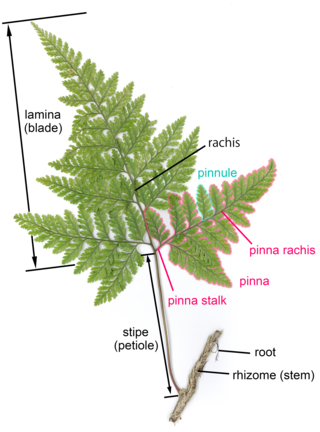
A frond is a large, divided leaf. In both common usage and botanical nomenclature, the leaves of ferns are referred to as fronds and some botanists restrict the term to this group. Other botanists allow the term frond to also apply to the large leaves of cycads, as well as palms (Arecaceae) and various other flowering plants, such as mimosa or sumac. "Frond" is commonly used to identify a large, compound leaf, but if the term is used botanically to refer to the leaves of ferns and algae it may be applied to smaller and undivided leaves.

Tribrachidium heraldicum is a tri-radially symmetric fossil animal that lived in the late Ediacaran (Vendian) seas. In life, it was hemispherical in form. T. heraldicum is the best known member of the extinct group Trilobozoa.
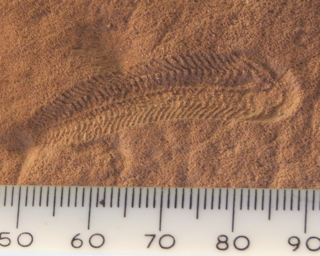
Spriggina is a genus of early animals whose relationship to living animals is unclear. Fossils of Spriggina are known from the late Ediacaran period in what is now South Australia. Spriggina floundersi is the official fossil emblem of South Australia; it has been found nowhere else.

Vendobionts or Vendozoans (Vendobionta) are a proposed very high-level, extinct clade of benthic organisms that made up of the majority of the organisms that were part of the Ediacaran biota. It is a hypothetical group and at the same time, it would be the oldest of the animals that populated the Earth about 580 million years ago, in the Ediacaran period. They became extinct shortly after the so-called Cambrian explosion, with the introduction of fauna forming groups more recognizably related to modern animals, however sponges may be descended from this clade. It is likely that the whole Ediacaran biota is not a monophyletic clade and not every genus placed in its subtaxa is an animal.

Sinovenator is a genus of troodontid dinosaur from China. It is from the early Cretaceous Period.
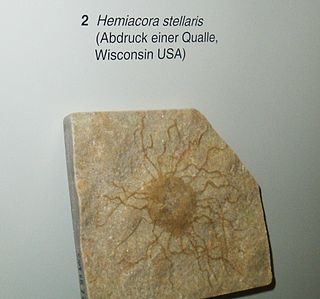
Hiemalora is a fossil of the Ediacaran biota, reaching around 3 cm in diameter, which superficially resembles a sea anemone. The genus has a sack-like body with faint radiating lines originally interpreted as tentacles, but discovery of a frond-like structure seemingly attached to some Heimalora has added weight to a competing interpretation: that it represents the holdfast of a larger organism.
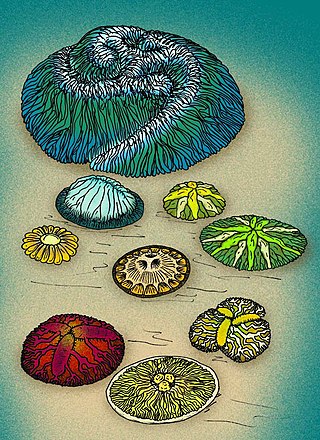
Trilobozoa is a phylum of extinct, sessile animals that were originally classified into the Cnidaria. The basic body plan of trilobozoans is often a triradial or radial sphere-shaped form with lobes radiating from its centre. Fossils of trilobozoans are restricted to marine strata of the Late Ediacaran period.

Praecambridium sigillum is an extinct organism that superficially resembles a segmented trilobite-like arthropod. It was originally described as being a trilobite-like arthropod, though the majority of experts now place it within the Proarticulata as a close relative of the much larger Yorgia. It is from the Late Ediacaran deposit of Ediacara Hills, Australia, about 555 million years ago. On average, P. sigillum had at least 5 pairs of segments, with each unit becoming progressively larger as they approach the cephalon-like head.

The Ediacaranbiota is a taxonomic period classification that consists of all life forms that were present on Earth during the Ediacaran Period. These were enigmatic tubular and frond-shaped, mostly sessile, organisms. Trace fossils of these organisms have been found worldwide, and represent the earliest known complex multicellular organisms. The term "Ediacara biota" has received criticism from some scientists due to its alleged inconsistency, arbitrary exclusion of certain fossils, and inability to be precisely defined.

Albumares brunsae is a tri-radially symmetrical fossil animal that lived in the late Ediacaran seafloor. It is a member of the extinct group Trilobozoa.
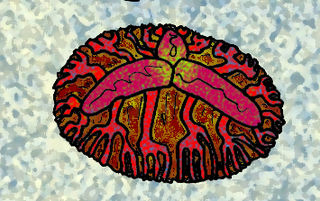
Anfesta stankovskii is a tri-radially symmetrical fossil animal that lived in the late Ediacaran (Vendian) seafloor. It is a member of the extinct group Trilobozoa.

Rugoconites is a genus of Ediacaran biota found as fossils in the form of a circular or oval-like impression preserved in high relief, six or more centimeters in diameter. The fossils are surrounded by frills that have been interpreted as sets of tentacles. The bifurcating radial ribs, spreading from a central dome, serve to distinguish this genus from the sponge Palaeophragmodictya, and may represent the channels of the gastrovascular system. Fossils of Rugoconites have been interpreted as early sponges, although this is countered by Sepkoski et al. (2002), who interpreted the organism as a free-swimming jellyfish-like cnidarian; similar to Ovatoscutum. However, the fossil is consistently preserved as a neat circular form and its general morphology does not vary, therefore a benthic and perhaps slow-moving or sessile lifestyle is more likely. Ivantstov & Fedonkin (2002), suggest that Rugoconites may possess tri-radial symmetry and be a member of the Trilobozoa.
The urbilaterian is the hypothetical last common ancestor of the bilaterian clade, i.e., all animals having a bilateral symmetry.

Eldoniids or eldonioids are an extinct clade of enigmatic disc-shaped animals which lived in the early to middle Paleozoic. They are characterized by their "medusoid" (jellyfish-shaped) bodies, with the form of a shallow dome opening below to an offset mouth supplemented by filamentous tentacles. Internally, they have a distinctive C-shaped cavity encompassing the gut, as well as hollow radial (radiating) structures arranged around a central ring canal. Most eldoniids are soft-bodied and can only be preserved in lagerstätten, but a few species may have hosted mineralized deposits. Historically, the affinities of eldoniids was enigmatic; recently, they been assessed as cambroernid deuterostomes. Their lifestyle is still an unresolved question; some authors reconstruct eldoniids as free-floating planktonic predators similar to jellyfish, while others argue that they were passive detritivores, embedded within the seabed for much of their life.
The Lantian Formation is a 150-meter-thick sequence of rocks deposited in Xiuning County, Anhui Province in southern China during a 90-million-year epoch in the Ediacaran period. Its algal macrofossils are the oldest large and complex fossils known.

The Dengying Formation is an upper Ediacaran fossiliferous geologic formation found in South China. It was deposited on a shallow marine carbonate platform.

Dendrogramma enigmatica is a species of siphonophore, the only one in its genus. It has been first described in 2014 on the basis of its morphology from a collection of specimens gathered in 1986. Its taxonomic affinity among animals was then unclear, but RNA from new specimens in 2016 allowed it to be identified as a siphonophore by barcoding and phylogenomics. The specimens are presumed to represent parts (bracts) of an entire siphonophore that has not been identified yet.
Eoporpita is a disc or ellipse-shaped Ediacaran fossil with unsure taxonomy/classification. It is known from its type species, Eoporpitamedusa, the only species within the genus Eoporpita.

Ichnusa is a genus of discoidal cnidarians that existed during the Ediacaran, 635-541 Million Years ago (MYA) discovered on the island of Sardinia, Italy. The genus is monotypic, only containing the species Ichnusa cocozzi. Palaeontologists think that Ichnusa represented a cnidarian of unknown affinities, with I. cocozzi being put in the Scyphozoa.
Staurinidia is a genus of Ediacaran soft-bodied organism from the deposits of the Ust'-Pinega formation. It is a monotypic genus, containing only the single species Staurinidia crucicula. The genus was first described in 1985 by Russian palaeontologist Mikhail A. Fedonkin. S. crucicula's four-fold symmetry is present as a result of four canals radiating from the middle of a small cavity in the middle of the body. Other forms with four way symmetry, mainly Medusoid forms, from the Ediacaran comprise an essential chunk of the Ediacaran diversity of symmetry; their organisations are similar to, though smaller than, those of a modern-day Scyphozoan Cnidarian.















